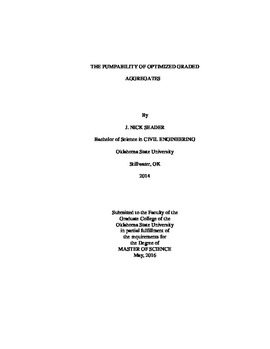| dc.contributor.advisor | Ley, Tyler | |
| dc.contributor.author | Seader, John N. | |
| dc.date.accessioned | 2017-02-22T22:16:19Z | |
| dc.date.available | 2017-02-22T22:16:19Z | |
| dc.date.issued | 2016-05-01 | |
| dc.identifier.uri | https://hdl.handle.net/11244/49152 | |
| dc.description.abstract | This work validates the gradation boundaries presented by Dr. M. Daniel Cook in his 2015 dissertation. A large variety of concrete gradations were pumped through a pipeline and their pressures were measured, analyzed, and compared. From this, recommendations for aggregates gradations were made to reduce required energy to pump a concrete mixture. A widely used field test, called the Slump Test, was used extensively in this project. Recommendations for slump were also given as a means to determine if a concrete is pump-able. Also, concrete containing air-entraining admixtures were tested to determine what happens when pumping air-entrained concrete. Along with these mixtures, a novel Rapid Shear Test was created as a means for determining whether shear properties of fresh concrete is a major factor in the property changes of pumped concrete. Together, these tests and results provide general recommendations and a framework for further comparative testing in the future. | |
| dc.format | application/pdf | |
| dc.language | en_US | |
| dc.rights | Copyright is held by the author who has granted the Oklahoma State University Library the non-exclusive right to share this material in its institutional repository. Contact Digital Library Services at lib-dls@okstate.edu or 405-744-9161 for the permission policy on the use, reproduction or distribution of this material. | |
| dc.title | Pumpability of Optimized Grade Aggregates | |
| dc.contributor.committeeMember | Russell, Bruce | |
| dc.contributor.committeeMember | Hartell, Julie | |
| osu.filename | Seader_okstate_0664M_14539.pdf | |
| osu.accesstype | Open Access | |
| dc.description.department | Civil Engineering | |
| dc.type.genre | Thesis | |
| dc.type.material | text | |
